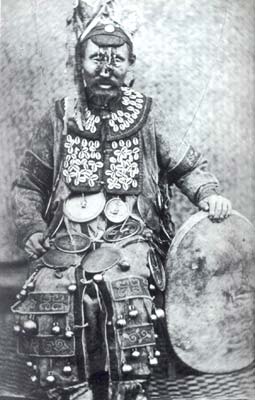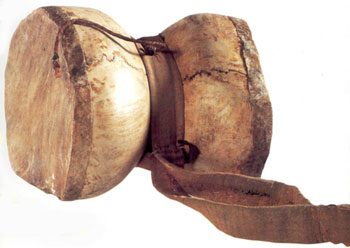
According to scholar Mircea Eliade, a shaman is a man or woman who "journeys" in an ecstatic trance, usually induced by rhythmic drumming. In its widest sense, a shaman is someone who has the specialist techniques for communicating with the higher reality by entering into an alternative state of consciousness, and drumming is one of the most common means through which the shaman enters this state.
In ancient times, it was said to be the shaman's job to make sure that the relationship between the human and divine world was kept harmonious and balanced. His essential role was to search for the unifying connections between the two realms. This is the quest of the mystic too. In mysticism, everything is vibration. Not only are all material forms made up of vibrations; we as humans also live and move in vibrations - they surround us as the fish is surrounded by water, and we contain them within ourselves, as the pond contains water. The drum, through its rhythms, replicates these vibrations, and it is not surprising that when we move to the rhythms of a drum we feel as though we're being carried along by the beat - a feeling of effortlessness and harmony that defies synchrony. This is why that the rhythm of the drum seems to lift time out of the realm of the ordinary as we know it, and transmutes it into timelessness. Truly, one of the properties of instrumental or sung music is that it can make time appear to stand still, lulling the sense of the listener, or even literally inducing sleep. That indeed is the principle of the lullaby, whose slow rhythm and repeated words and phrases promote a state of soothing and calming drowsiness.

Another archetypal and natural human activity that gave rise to a musical instrument is the simple act of clapping. All over the world, this quasi-spontaneous gesture, the sound of which varies according to the position of the hands, provides the most common rhythmic accompaniment to the voice, and is also used to show enthusiasm in the form of applause. Clapping is an instinctive action that has an invigorating effect on the whole body by stimulating nerves residing on the palms of the hands. Due to this attribute, it is often a part of yogic therapy too. Truly, after or during a musical performance, this idiophonic beating brings the listener's body into the experience and helps to release the pent-up energy aroused by the music and the rhythm.
From clapping with his own hands, man graduated next to crafted clappers, which were held in both hands and were clashed together to produce sounds greater in intensity than those generated by the mere hands.

Such a pair of instruments, known as cymbals, continues to find use in religious rituals, including those of Hinduism and Buddhism.

These cymbals are used to punctuate sacred texts, whether read aloud, sung or chanted. In metaphysical terms, the beating together of cymbals is said to signify the symbolic union of opposites, wherein the naturally occurring male and female polar energies are combined, an activity which is necessary to maintain the harmony of the dynamic universe. Thus says an ancient Tibetan proverb: 'With only one wing, a bird cannot fly.'

As expressed in the example of the cymbals above, after deriving music from his own body, the next natural step for man was to devise instruments that were an extension of himself. Clearly, such implements had to be in close physical proximity to the musician. It is possible to imagine a variety of different such instrumental extensions. The breath, for example, is extended into pipes (flutes), and transformed into music when these are raised to the lips. Similarly, the tongue and its vibratory capability is extended by the means of the primitive reed that consists of a leaf or a blade of grass held by the fingers in front of the lips.

Fundamental to man's attempts to dominate, or at the very least placate the forces of nature, is the need to establish an analogy between nature and instrument, based on their common origin. Once the concept that all things are interrelated is acknowledged, and that each one affects the rest at every level in the relationship of cause and effect, then the magical principle is established which states that it is only necessary to influence one part of the whole in order to extend that influence to the totality. Thus a harmonious relationship existed, and continues to do so, between the human body and the musical instrument, for the one cannot operate without the other. Without his or her instrument, a musician may be likened to an amputee or a rider without his horse. Both are made up of body and soul, and together they become like two human beings, whose identities merge (as in the case of the cymbals mentioned above), in the playing of the instrument, giving rise to a higher reality. One only has to observe a sitar player in action to note the loving and energetic tenderness with which he or she seems to caress the instrument, speak to it, coax sounds out of it, making it vibrate and respond with sweet melodies and eloquent phrases.

In Tibet, the human cranium is used in making the damaru, a drum with whirling balls, here two skulls are combined and, according to the holy texts, it is preferable for these to be taken respectively from a boy of sixteen and a girl of twelve. Monkey skins are stretched over the skulls, and one end is decorated with an eight-petalled lotus smeared with a girl's menstrual blood, and the other end with a mandala. Sixteen pierced holes allow the skin to be attached using human hair. The whirling balls are made of bones taken from a waterbird's foot and encased in wax and cloth.
True to its character, Tantric philosophy takes this identification of man with instrument to its physical extreme, even to the extent of fashioning instruments out of different parts of the human body. For example, the Tibetan ritual trumpet 'rkang-gling' utilizes the male femur, the name itself means 'made of a man's leg.' This ideal is further expressed in the hourglass shaped drum with whirling balls, known in Sanskrit as 'damaru,' its shape echoing the inexorable passage of time. This drum is fashioned out of the human cranium, and is comprised of two skulls, taken respectively from a boy of sixteen and a girl of twelve. To consecrate it, and metaphorically infuse it with a magical life, the male side is smeared with sperm and female half with menstrual blood.

Damaru drum with whirling balls
In the shape of an hourglass, it is also called a skull drum when made from human crania. Here the body is made of wood (carved in imitation of two skullcaps) and is decorated overall with paintings of religious scenes. The damaru is used in a variety of ceremonies, often in association with the rkang-gling. It is normally played inside Tibetan monasteries or by Bon monks.
Essentially, the damaru is composed of two inverted triangles with their apexes meeting at the center. The upward triangle suggests the fiery linga of Shiva, and the lower pointing triangle represents the female yoni. The point where they meet is of course once again the higher, transcendent reality, where all dualities merge giving rise to a refreshing oneness. This point is the primordial bindu, or the dimensionless entity that gives rise to all creation.

The damaru is considered so sacred in Indian thought that rules are suggested even for the correct positioning of this drum when it is not being played. It is canonized that it should never be put down on its end, but positioned so that the male skull is to the musician's right, while the female skull is to his left. This arrangement follows the traditional established order of father/mother, right/left, and masculine/feminine.
The use of materials taken from human bodies has magical implications, linking the human, animal, vegetable and mineral worlds in an indissociable whole. By taking possession of these elements and controlling them in this way, man expresses his all embracing mystical and harmonious vision of the world.
Indeed, music has since time immemorial been the universal vehicle for man's attempts to reach out to a higher dimension of reality. The Upanishads state that this supreme domain is not a physical state of being, but is intangible and unsubstantial. Therefore, to gauge this supernormal state, man requires a symbolic medium that is similarly abstract, yet spiritually potent enough to withhold its essence, and is at the same time discernable to one or more of his sense organs. Music is the means by which he makes this leap into the unknown. To communicate with the intangible other world that lies just beyond our reach, it is necessary to transcend the material universe, so that no physical obstacle stands in the way of divine influence. Apprehending the material world solely in terms of its sounds has the effect of rendering it insubstantial, so that it becomes no more than a vibration in the air, intangible, yet graspable to a sense organ (ears). Hence does man fulfill his mystical destiny.